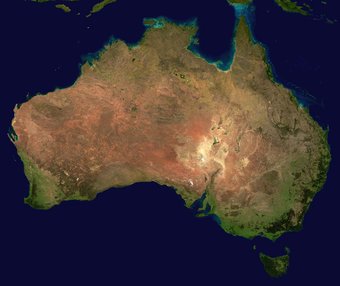Geography of Australia
|
|
The geography of Australia encompasses a wide variety of biogeographic regions being the world's smallest continent but the sixth-largest country. The population is concentrated along the eastern and southeastern coasts.
Australia is the only country to occupy an entire continent rather than island.
Australia is in a continental tectonic plate of the Indo-Australian Plate.
| Contents |
Area and boundaries
Location: Oceania, continent between the Indian Ocean and the South Pacific Ocean
Geographic coordinates: Template:Coor dm)
Map references: Oceania
Area:
- total: 7,686,850 km˛
- land: 7,617,930 km˛
- water: 68,920 km˛
- note: includes Lord Howe Island and Macquarie Island
Area comparative
- Canada comparative: about 4 times bigger than Nunavut
- United Kingdom comparative: about 31.5 times bigger than the UK
- United States comparative: slightly smaller than the US contiguous 48 states
Land boundaries: 0 km
Coastline: 25,760 km
Maritime claims:
- contiguous zone: 24 nautical miles
- continental shelf: 200 nautical miles or to the edge of the continental margin
- exclusive economic zone: 200 nautical miles
- territorial sea: 12 nautical miles
Climate and terrain
Clim_map_kpngrp.jpg
By far the largest part of Australia is desert or semi-arid — 40% of the landmass is covered by sand dunes. Only the south-east and south-west corners have a temperate climate and moderately fertile soil. The northern part of the country has a tropical climate: part is tropical rainforests, part grasslands, and part desert.
Rainfall is highly variable, with frequent droughts lasting several seasons. Occasionally a duststorm will blanket a region or even several states and there are reports of the occasional large tornado. Rising levels of salinity and desertification in some areas is ravaging the landscape.
Australia is situated in the middle of the tectonic plate, and therefore has no volcanism, although it may sometimes receive minor earthquakes. The terrain is mostly heavily weathered, low plateau with deserts, rangelands and a fertile plain in southeast. Tasmania and the Australian Alps contain a number of permanent icefields and numerous glaciers. The Great Barrier Reef, by far the world's largest coral reef, lies a short distance off the north-east coast. Uluru, in central Australia, is the second largest monolith in the world.
Tropical and subtropical location and cold current along the western coast have made western Australia a hot desert with aridity, a marked feature of greater part of the continent.A 2005 study by Australian and American researchers [1] (http://www.gsajournals.org/gsaonline/?request=get-abstract&doi=10.1130%2FG21033.1) investigated the desertification of the interior, and suggested that one explanation was related to human settlers who arrived about 50,000 years ago. Regular burning by these settlers could have prevented monsoons from reaching interior Australia.
Elevation extremes:
- lowest point: Lake Eyre: -15 m
- highest point: Mount Kosciuszko: 2,229 m
See also:
Natural resources and land use
Topography_of_australia.jpg
Natural resources include: bauxite, coal, iron ore, copper, tin, gold, silver, uranium, nickel, tungsten, mineral sands, lead, zinc, diamonds, natural gas, petroleum.
Australia is home to the Great Artesian Basin - an important source of water for people and cattle in the parched outback. This basin is the world's largest and deepest fresh water basin.
Land use:
- arable land: 6%
- permanent crops: 0%
- permanent pastures: 54%
- forests and woodland: 19%
- other: 21% (1993 est.)
Irrigated land: 21,070 km˛ (1993 est.)
Natural hazards: cyclones along the northern coasts; severe thunderstorms, droughts and occasional floods; frequent bushfires
Environment
Current issues: soil erosion from overgrazing, industrial development, urbanization, and poor farming practices; soil salinity rising due to the use of poor quality water; desertification; clearing for agricultural purposes threatens the natural habitat of many unique animal and plant species; the Great Barrier Reef off the northeast coast, the largest coral reef in the world, is threatened by increased shipping and its popularity as a tourist site; limited natural fresh water resources
International agreements:
- party to: Antarctic-Environmental Protocol, Antarctic Treaty, Biodiversity, Climate Change, Endangered Species, Environmental Modification, Hazardous Wastes, Law of the Sea, Marine Dumping, Marine Life Conservation, Nuclear Test Ban 1963, Nuclear Non-Proliferation, Ozone Layer Protection, Ship Pollution, Tropical Timber 1994, Wetlands, Whaling
- signed, but not ratified: Climate Change-Kyoto Protocol, Desertification
Extreme points
This is a list of the extreme points of Australia, the points that are farther north, south, east or west than any other location on the continent.
Australia (mainland)
- Northernmost Point — Cape York, Queensland (10°41'S)
- Southernmost Point — Wilsons Promontory, Victoria (39°08'S)
- Westernmost Point — Steep Point, Western Australia (113°09'E)
- Easternmost Point — Cape Byron, New South Wales (146°22'E)
- Lowest Point — Lake Eyre: -15 m
- Highest Point — Mount Kosciuszko: 2,229 m
Australia (country, including islands)
- Northernmost Point — Boigu Island, Torres Strait Islands, Queensland
- Southernmost Point — Macquarie Island, Tasmania ¹
- Westernmost Point — Flat Island, McDonald Islands ²
- Easternmost Point — Norfolk Island
- Highest Point — Mawson Peak, Heard Island: 2,745 m
Australian Antarctic Territory
- Westernmost Point — (45°00'E)
- Easternmost Point — (160°00'E)
- Southernmost Point — South Pole
¹ The southernmost point of the main island group is South East Cape, Tasmania.
² The westernmost point of the main island group is Dirk Hartog Island, Western Australia.
References
- Miller, Gifford et al. Sensitivity of the Australian Monsoon to insolation and vegetation: Implications for human impact on continental moisture balance (http://www.gsajournals.org/gsaonline/?request=get-abstract&doi=10.1130%2FG21033.1). Geology Vol. 33, No. 1, pp. 65–68.
- Template:CIA WFB 2000
See also
- Australia
- National parks (Australia)
- Ecoregions of Australia
- Australasia ecozone
- Australia-New Guinea
- List of regions in Australia
- Multimedia-based maps and pictures of Australia (http://www.kartovision.de/australien/australienmap_eng.html)de:Geografie Australiens

